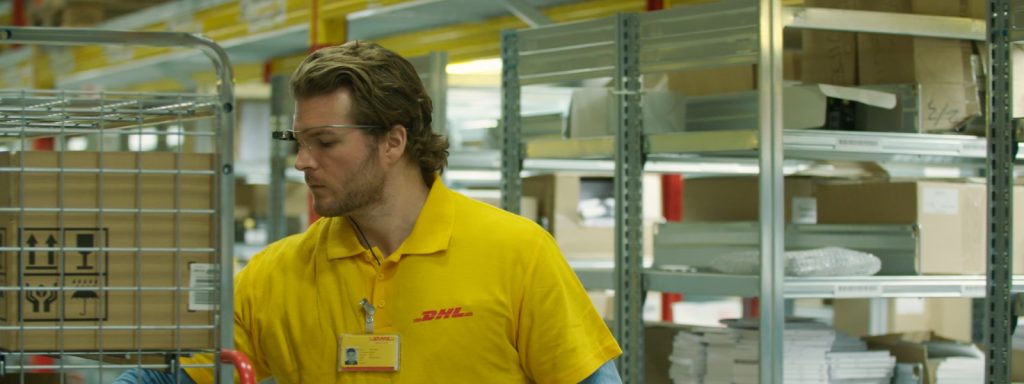Nearly everything we buy, eat, or wear… moves through supply chains once we go through the buying and selling process. Businesses that help in these endeavors account for 7.5% of U.S. GDP. Due to the high costs of moving these types of goods, corporations are always looking to find ways to save money, without diminishing quality, and continuing to improve service. Augmented reality may be the answer.
Augmented reality has the potential to transform the software used to manage supply chains. Using only sensors on packaging, company workers will be able to perform an advanced analysis of how well products are doing in real-time. A factory can flex their production speeds and outputs based on that day’s sales. Manufacturers can cut their losses by making fewer products and redistributing items to where the demand is. Sales processes are cut in half and customer loyalty increases.
Inventory and Warehouse Services
Augmented reality is being used in warehouses to quickly find products and pack them in boxes for distribution. DHL has successfully carried out a pilot project testing smart glasses and augmented reality in a warehouse in the Netherlands.
In cooperation with DHL customer Ricoh and wearable computing solutions expert Ubimax, the technology was used to implement ‘vision picking’ in warehousing operations.
Staff was guided through the warehouse by graphics displayed on the smart glass to speed up the picking process and reduce errors.

Robots and Human Augmentation
Warehouse employees can wear AR glasses that let them see what a robot working in a warehouse sees, or scan each product for damage. Warehouse employees can also map out a robot’s path, while the robot will listen and take over the tedious repetitive, or dangerous, tasks that the employee may not be capable of doing alone. We can leverage the employee for their strengths such as awareness, perception, and decision making, while the robot’s strengths are precision, physical strength, and repetitiveness.
HMDs, in combination with a system of sensors and cameras, also enable logistics companies to optimize trailer loading by showing workers where to best place a package in order to load the trailer most efficiently and increase productivity.
Last Mile Delivery Enhancement
In logistics, the last-mile of delivery to customers is also the most expensive. Last mile delivery is defined as the movement of goods from a transportation hub to the final delivery destination. Augmented reality can save money by cutting the time spent on last-mile delivery nearly in half.
According to a DHL report, drivers spend 40% to 60% of their day searching inside their own truck for the correct boxes to deliver next. Instead of having to remember how their truck was loaded that morning, augmented reality is used to identify, tag, sequence, and locate every parcel. Combined with artificial intelligence, AR glasses can also navigate the driver to the right door for delivery. These systems will record each and every delivery so that new drivers will benefit from past driver experiences. In the near future, every driver will be given a graphic overlay of each building they encounter.
Procurement
The distributed ledger capability of blockchain is being combined with augmented reality to bring transparency and traceability to procurement. The entire supply chain falls apart when customers can’t be assured of a product’s origin or authenticity.
Shortening Sales Processes
For sales teams, using augmented reality technology in their sales processes, will evolve into a facilitating experience that will save money and shorten the time that customers receive their products and services. Using ThingWorx Studio, Fujitsu, who is a global communication and information technology company offering a full range of products, solutions and services, created highly-immersive AR experiences for its sales team to virtually demonstrate how products would look and function in a customer’s environment, in real time, and at scale.

Customers experience graphic, lifesized product demonstrations in which they interact with products virtually to gain a more in-depth understanding of product features and benefits. As a result, Fujitsu no longer needs to ship physical products to customer sites for demonstrations, saving significant time and resources.
The sales team is also able to demonstrate configuration options, features and capabilities on-the-fly for products yet to be manufactured, speeding the customer approval process and shortening order fulfillment times. Equipped with only an
iPad, HoloLens, smartphone, or tablet, the sales person can demonstrate every product detail, feature, and function, down to cabling installation and identifying locations power sources that would be needed.
Augmented reality helps to shorten sales cycles by empowering customers to be more engaged and make more confident purchasing decisions. ThingWorx Studio enables Fujitsu to deliver unique AR experiences to its customers and provide unlimited potential for its sales organization.
In Conclusion
There are boundless opportunities for pushing creative, innovative AR experiences ahead of the curve, and taking advantage of it from a profitable standpoint. It is the right time for companies to consider how they can best make use of this emerging platform before the majority follows suit. It will be these companies that will help shape a dawning era and create amazing human experiences with it.




